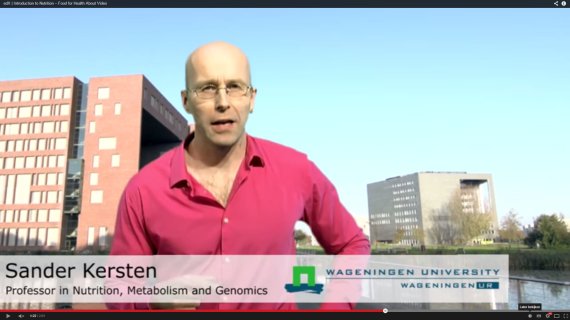Imagine lecturing to the camera all afternoon and then seeing all the film going straight into the bin. That happened to professor of Nutrition Sander Kersten last September when he and other educational pioneers were working on the first MOOC. On 27 November he will share his experiences with colleagues in an information session called How to cook a MOOC.
Wageningen University is due to launch its first MOOC early in 2015. Then, students from all around the world will be able to follow a free online version of the BSc module Introduction to nutrition. This will be followed two weeks later by an online course on optimal crop yields from Plant Production Systems. The two courses are an advert for the university.
‘The challenge is to hold the student’s attention’
Deadly dull
‘I was pretty fed up,’ says Kersten, looking back on the filming incident, when the background was all wrong. ‘But that black was deadly for the ambiance. The quality was not what we wanted. An online course like this must be kind of slick, with professional and appealing images.’ Setting up an online course is quite unlike running a conventional course, says Ulrike Wild, Online Learning programme director. ‘A MOOC is pretty casual. You can sign up with one click of the mouse, but after that you have no obligation to follow lectures or get points. So the challenge is to hold the student’s attention.’ Given that MOOCS have only existed for a couple of years, it is a question of giving it a try and learning from others. Which is exactly what Wild has been doing. She took quite a number of MOOCS, including courses on Greek mythology and social psychology. Partly out of interest, but always with a professional eye. ‘How do they do it? What would I do differently?’ Wild came across some good and some terrible examples. ‘There are MOOCS around that are deadly dull.’
Making a MOOC demands all sorts of new skills and gives you a change from your regular teaching work, the skills for which you do have under your belt. I have put an awful lot of time and work into this, and I haven’t regretted it for a moment.’
Sander Kersten, professor of Food, Metabolism and Genomics
‘It was incredibly nice to work on this in a team. I see my subject in quite a different light now. You are quicker to adopt something innovative: animations or a short film.’
Gerry van de Ven, assistant professor at Plant Production Systems
A lot of trial and error goes into the making of a MOOC, as Kersten has noticed. After his wasted afternoon, the black screen was scrapped and the team at the Dreijen got a studio with a green screen. Teachers can record ‘knowledge clips’ here: mini-lectures of around 10 minutes in length. Teachers have to point in the air, rather like a weather forecaster on TV. Illustrations are added later by computer: a schematic digestion system placed behind the teacher, for example. The teachers are working with a team which also includes education experts and multimedia experts. A knowledge clip of this kind demands a lot more thinking and preparation than a lecture. And giving a lecture in front of a camera is a different ballgame to talking to a room full of students. At every stumbling block students drop out. After all, if they don’t understand something they cannot just put their hands up. So Kersten writes out his lecture word for word and reads it from an improvised autocue. That way he knows there is a logical line to the text and he can deliver it without hesitations and ums and ahs. Wild: ‘This challenged us to be very alert to that. Online courses have drawn a lot of attention to teaching methodology and techniques.’ If the video does not play automatically, click here
Green screen According to Wild, the experiences gained with the MOOCs can be of interest to the teaching in Wageningen across the board. The innovation around new courses tends to spread to the rest of the courses. Green screens, for instance, are being used by other teachers too now. ‘They discovered that they are better off explaining the basics of genetics in three effective video clips than repeating the material 100 times in the classroom. That is exactly what the Growth committee proposed earlier this year. By making good use of technology Wageningen University can maintain a good standard of education even while student numbers grow.’ Kersten has benefitted from the MOOCs himself too. When he gives his course on campus now he uses his films. That frees up more time for seminars and intensive supervision by teachers. Meanwhile he is waiting to see how many people sign up for his course. Kersten hopes for 30 to 40 thousand. Probably more than all the students he has ever taught in the classroom.
Photo: Sven Menschel



